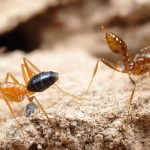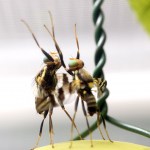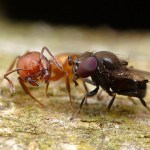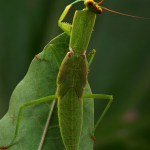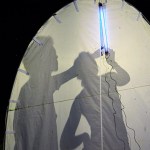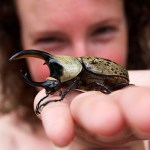insects
Pheidole rosae, major worker, Entre Rios, Argentina
At the nest entrance
photo details: Canon MP-E 65mm 1-5x macro lens on a Canon EOS 20D
ISO 100, 1/250 sec, f/13, flash diffused through tracing paper
Many plants depend so heavily on visits from bees that they go to great lengths to attract them, using brightly coloured flowers baited with sweet nectar. But some of their tricks are much subtler and are designed not to attract six-legged visitors, but to make their stay more convenient.
The majority of flowering plants have evolved special conical cells that line the surface of their petals and are found nowhere else. These cells provide the flower with a rougher texture that is indistinguishable to human fingers, but that provide just enough purchase for the claws of landing insects.…
...well, not really. But an exchange I had at Photo Synthesis with Andrew Bleiman of Zooillogix got me thinking about all the different insects that have charmingly envenomated me at one time or another.
Myrmecia piliventris, Australia
So I'm starting a meme called Things That Have Stung Me. The rules are simple:
List all the things that have stung you.
Bites don't count.
Pass the meme to 3 or more other bloggers you suspect have also been well-zinged.
Here are mine.
Things that have stung me:
Ants:
Pachycondyla verenae
Pachycondyla harpax
Pachycondyla villosa…
In Mexico's Cueva del Azufre (the Sulphur Caves), a small fish called the shortfin molly (Poecilia mexicana) is on the way to becoming two separate species. Those that live in the dark interior of the caves are very different to their relatives that swim in the bright, surface waters. They have lighter colours and live more solitary lives. Their eyes are smaller, less sensitive and have lower levels of light-sensitive pigment. Instead, they rely instead on a hypersensitive pressure detector - the lateral line - to sense disturbances in the water.
Their differences aren't just skin deep…
As the sun sets on a wonderful set of insect photos from the Wild...
I thought I should start with a transition photo, on a photosynthetic bug bed, to a new photo theme - rockets:
Many insects have served as brave cosmonauts - flying as a somewhat unwilling payload in Estes rockets. The National Association of Rocketry has rules against living payloads, but they make an exception for invertebrates. (I think the intent of the rule was to prevent kids from flying their sister's pet, but to allow for some curious exploration.)
The Quark is the smallest rocket I have built, with rear-swept…
Most people are aware that social insects, like honeybees, have three "sexes": queens, drones and workers.
Drones are males. Their only job is to fly out and mate with the queen after which they drop dead.
Female larvae fed 'royal jelly' emerge as queens. After mating, the young queen takes a bunch of workers with her and sets up a new colony. She lives much longer than other bees and spends her life laying gazillions of eggs continuously around the clock, while being fed by workers.
Female larvae not fed the 'royal jelly' emerge as workers.
Workers perform a variety of jobs in the hive.…
Although these two ants in northern Argentina look like they're ignoring each other, they are in fact doing just the opposite. This end-to-end confrontation is an intense chemical duel. What's particularly interesting about the image is the juxtaposition of two different defense systems.
At left is Forelius nigriventris, a speedy little insect armed with a nozzle at the tip of the abdomen that releases a chemical cocktail into the air. The Forelius colony discovered a breach in the mound of a neighboring fire ant Solenopsis invicta and has recruited hundreds of workers to pilfer the tasty…
Two male Rhagoletis walnut flies joust on an artificial walnut in a lab cage at the University of Arizona. What's an artificial walnut? It's a painted ping pong ball. As long as the ball is the right color and shape, the flies apparently don't mind.
Biologist Jeremy Davis uses these flies to study the interaction between fruit quality and fly behavioral ecology.
Of course, for the flies it's all about access to females.
Technical details.
top photo: Lens: Canon MP-E 65mm 1-5x macro lens
Body: Canon EOS 20D dSLR
Flash: Canon 550EX flash, indirect
Settings: ISO 200, f/11, 1/200 sec
middle…
The success of termites Âand other social insects hinges on their complex social systems, where workers sacrifice the ability to raise their own young in order to serve the colony and its queen - the only individual who reproduces. But this social order can be thrown into chaos by knocking out a single gene, and one that originally had a role in that other characteristic termite ability - eating wood.
Judith Korb from the University of Osnabrueck in Germany found that the queen termite relies on a gene called Neofem2 to rule over her subjects. Korb worked with the termite Cryptotermes…
We recognise dead people by the absence of signals that indicate life - movement, responsiveness, pulses, brain activity, and so on. The Argentine ant does the same, but its signal is a chemical one. Throughout its life, an ant uses chemicals in its skin to automatically send out a message to its nest-mates, saying "I'm alive. Don't throw me out." When it dies, these "chemicals of life" fade away, and their bodies are evicted.
Social insects like ants and honeybees are fastidious about their colony's tidiness. If any individuals die, they're quickly removed and thrown away in one of the…
A Crematogaster ant is held up by a kleptoparasitic Milichia patrizii ant-mugging fly.
Last July, while wandering about the coastal forests of St. Lucia in eastern South Africa, I happened across an intriguing scene half-way up a spiny Acacia trunk. Some diminutive gray flies were pestering a trail of ants as they walked along the tree.
The flies' exact activities were hard to observe with the naked eye, but it looked like nothing I'd ever seen. They seemed to be grabbing ants, pinning them to the trunk, and after a few seconds letting them go again.
The macro lens on my camera serves as…
Orthodera ministralis - Garden Mantis (immature)
Melbourne, Australia
Technical details:
Lens: Canon 100mm f2.8 macro lens
Body: Canon EOS D60 dSLR
Flash: Canon 550 EX, bounced off white paper above mantid
Settings: ISO 100, f/19, 1/200 sec
Impressionists are a mainstay of British comedy, with the likes of Rory Bremner and Alistair MacGowan uncannily mimicking the voices of celebrities and politicians. Now, biologists have found that tiger moths impersonate each other too, and they do so to avoid the jaws of bats.
Some creatures like starlings and lyrebirds are accomplished impersonators but until now, we only had anecdotal evidence that animals mimic each others' sounds for defence. Some harmless droneflies may sound like stinging honeybees, while burrowing owls deter predators from their burrows by mimicking the…
..over at Photo Synthesis:
How to attract an entomologist
Agrarian ants
Another way to humanize an insect photo
Ants in the New York Times
Photo technique: the white box
Humanizing the hordes: Anthropomorphism and science photography
Step 1. Locate a suitable patch of forest, field, or desert.
Step 2. Wait for a warm, moonless summer night.
Step 3. Using a long extension cord, plug in a blacklight. Or even better, a mercury-vapor lamp.
Step 4. Sit back and watch your prey arrive.*
*disclaimer. This technique works generally for most entomologists, but if your needs are more specific, you will wish to employ more specialized methods. Forensic entomologists prefer roadkill, for example.
Today, Roche announced funding for over a dozen genomes of organisms associated with the agricultural attine ants and the fungus they cultivate. In honor of the occasion, here's a sampling of a few of the attine species and their gardens.
Acromyrmex sp. nr. crassispinus, Argentina.
The fungus of the texan species Mycetosoritis hartmanni is grown on a substrate of caterpillar frass. Not all the attines are leaf-cutters!
Acromyrmex lundii, Argentina.
Apterostigma auriculatum, Panama.
Atta texana, Texas.
Cyphomyrmex wheeleri, Arizona.
Trachymyrmex pomonae, Arizona.
The…
Seriously, is there a name for the disorder whereby people think everything with wings is a honeybee?
Atta cephalotes, in the fungus garden
Big ant news today! Roche Applied Sciences is apparently funding the sequencing of a series of genomes- three ant and an array of fungal and microbial genomes- in an ambitious project to better understand the relationships among the players in the celebrated ant-fungus relationship. The sequencing project is headed by Nicole Gerardo of Emory University and Cameron Currie of the University of Wisconsin.
This trend in genomics away from sequencing isolated organisms in favor of comparative projects is a welcome one. With multiple…
[This is a repost from the Myrmecos Blog, originally published February 2008]
In 1934, a diminutive book by an unknown author seeded the largest conservation movement in history. The book, Roger Tory Peterson's A Field Guide to the Birds, pioneered the modern field guide format with crisp illustrations of diagnostic characters, all in a pocket-sized read. The Guide sold out in a week, but the book's effects are ongoing.
To understand the magnitude of Peterson's impact, consider how naturalists traditionally identified birds. They'd take a shotgun into the field, and if they saw something…
...is to add an actual human.
Dynastes granti - Western Hercules Beetle, Arizona
It's funny how our social primate brain works. We gain immediate emotional access to an image simply by inserting a member of our own species.
(Incidentally, that's one reason why David Attenborough's Life in the Undergrowth is so effective. With Attenborough able to share the screen with tiny arthropods, the result of a new generation of optics, that whole miniature world seems suddenly available.)
Technical details:
Lens: Canon 17-40 f4.0L wide angle zoom lens
Body: Canon EOS 20D dSLR
Settings: ISO 400…

